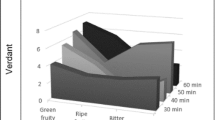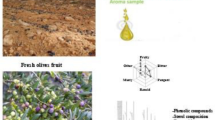Abstract
The purpose of this investigation was to compare the performance of the bromthymol blue (BTB) method and the Uniform Oil Color Scale (UOCS) method with different sets of virgin olive oil samples from Andalusia (Spain), namely, 1213 samples from olives at three stages of ripeness, 1008 samples from eight olive varieties, and 1700 samples from olives harvested in four different crop seasons. All oils were extracted in the laboratory by the same procedure. The performance of the two color scales was compared using CIELAB color differences between the oil samples and the nearest standard from each scale. The UOCS performed at least 2.0 times better than the BTB for each of the three stages of olive ripeness, and the difference between the two color scales was statistically significant (P<0.001). The UOCS performed at least 1.3 times better than the BTB for each of the eight olive varieties studied, and the differences between the two color scales were statistically significant (P<0.02). The UOCS also performed at least 1.6 times better than the BTB for each of the four harvests analyzed, and the differences between the two color scales were statistically significant (P<0.001). Using the current oil samples, we could discern no substantial improvements to the UOCS standards.
Similar content being viewed by others
References
Gutiérrez, R., and F. Gutiérrez Método Rápido para Definir y Clasificar el Color de los Aceites de Oliva Vírgenes, Grasas Aceites 37:282–284 (1986).
AENOR, Índice de Color ABT. Norma UNE 55021, Asociación Española de Normalización y Certificación, Madrid, 1997.
Civantos, L., La Olivicultura en el Mundo y en España, in El Cultivo del Olivar, 4th edn., edited by D. Barranco, R. Fernández-Escobar, and L. Rallo, Mundi-Prensa, Consejería de Agricultura y Pesca (Junta de Andalucía), Madrid, 2001, pp. 17–34.
Melgosa, M., M.M. Pérez, E. Hita, M.J. Moyano, J. Alba, and F.J. Heredia, Precision and Accuracy in the Color Specification of Virgin Olive Oils from the Bromthymol Blue Method, J. Am. Oil Chem. Soc. 77:1093–1099 (2000).
Melgosa, M., M.M. Pérez, E. Hita, F.J. Heredia, J. Alba, and M.J. Moyano, Reproducibility of the Bromthymol Blue Standards Used for Color Specification of Virgin Olive Oil, Ibid. 78:265–270 (2001).
Melgosa, M., R. Huertas, E. Hita, J.M. Roa, F.J. Heredia, J. Alba, and M.J. Moyano, Proposal of a Uniform Color Scale for Virgin Olive Oils, Ibid. 81:323–330 (2004).
International Commission on Illumination (CIE), CIE Publication No. 15.2: Colorimetry (Technical Report), CIE Central Bureau, Vienna, 1986.
Alba, J., J.R. Izquierdo, and F. Gutiérrez, Aceite de Oliva Virgen: Análisis Sensorial, Agrícola Española, Madrid, 1997.
Uceda, M., and M. Hermoso, La Calidad del Aceite de Oliva, in El Cultivo del Olivar, 4th edn., edited by D. Barranco, R. Fernández-Escobar, and L. Rallo, Mundi-Prensa, Consejería de Agricultura y Pesca (Junta de Andalucía), Madrid, 2001, pp. 571–596.
Civantos, L., Obtención del Aceite de Oliva Virgen, 2nd edn., Agrícola Española, Madrid, 1999.
Fiorino, P., and F. Nizzi, Maturazione delle Olive e Variazioni di Alcuni Componenti dell'Olio, Olivae 35:25–33 (1991).
Pannelli, G., and M. Servilli, Osservazioni Poliennali sulle Variazioni di Parametri Agronomic Durante la Maturazione di Frutti di Cultivar Precoci e Tardie di Olivo, Olea (September 1991).
Moyano, M.J., Estudio del Color de Aceites de Oliva Vírgenes de Andalucía, Ph.D. Dissertation, Facultad de Farmacia (Universidad de Sevilla), Instituto de la Grasa (CSIC), Spain, 2002.
Martínez, J.M., E. Muñoz, J. Alba, and A. Lanzón, Informe Sobre Utilización del Analizador de Rendimientos “Abencor”, Grasas Aceites 26:379–385 (1975).
Barranco D., Variedades y Patrones, in El Cultivo del Olivar, 4th edn., edited by D. Barranco, R. Fernández-Escobar, and L. Rallo, Mundi-Prensa, Consejería de Agricultura y Pesca (Junta de Andalucía), Madrid, 2001, pp. 61–89.
Berns, R.S., Billmeyer and Saltzman's Principles of Color Technology, 3rd edn., John Wiley & Sons, New York, 2000, pp. 157–159.
Cui, G., M.R. Luo, B. Rigg, G. Roesler, and K. Witt, Uniform Colour Spaces Based on the DIN99 Colour-Difference Formula, Color Res. Appl. 27:282–290 (2002).
International Commission on Illumination (CIE), CIE Publication No. 142: Improvement to Industrial Color-Difference Evaluation (Technical Report), CIE Central Bureau, Vienna, 2001.
Pérez, C., Técnicas Estadísticas con SPSS ®, Prentice Hall, New York, 2001.
Author information
Authors and Affiliations
Corresponding author
About this article
Cite this article
Melgosa, M., Huertas, R., Hita, E. et al. Performance of two color scales for virgin olive oils: Influence of ripeness, variety, and harvest season. J Amer Oil Chem Soc 82, 21–25 (2005). https://doi.org/10.1007/s11746-005-1037-x
Received:
Accepted:
Issue Date:
DOI: https://doi.org/10.1007/s11746-005-1037-x




